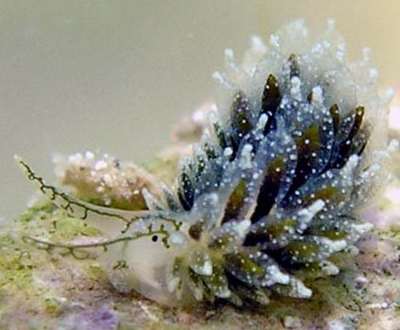
Ercolania sp. 5
Order: SACOGLOSSA
Superfamily: LIMAPONTIOIDEA
Family: Limapontiidae
PHOTO
Eelgrass Beds, 1.5 m, Saipan, Northern Mariana Islands, Pacific Ocean, 04 January 2006, Backside of stone on sands. Length: 10 mm. Photographer: Yukari Tani.
See Cynthia Trowbridge's message [#16360] for discussion on the identity of this species.
See Kathe Jensen's message [#19873] suggesting this is a mixture of two species one of which is Ercolania coerulea
Authorship detailsRudman, W.B., 2006 (April 20) Ercolania sp. 5 [In] Sea Slug Forum. Australian Museum, Sydney. Available from http://www.seaslugforum.net/find/ercosp5
Related messages
Re: Ercolania sp. 5 - from the Red Sea
March 20, 2008
From: Binyamin Koretz
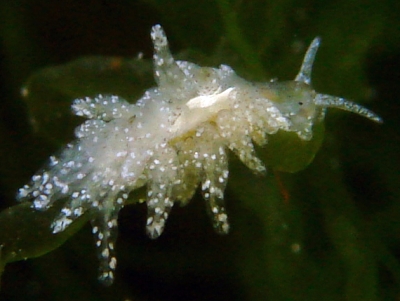
Concerning message #19445:
Hi Bill,
This tiny little fellow looks to us like the slugs you're calling Ercolania sp. 5 except that his digestive tracts don't seem to have turned green yet. I assume he's feeding on the algae?
Locality: Eilat, Tables South, 8 m, Israel, Red Sea (Gulf of Eilat), 15 Feb 2008, sandy slope, some corals, all covered with filamentous algae. Length: 3 mm. Photographer: Binyamin and Shulamit Koretz.
thanks and regards
Binyamin
binyamin@koretz.net
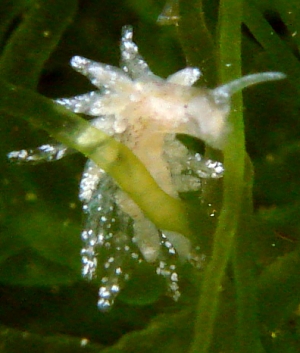
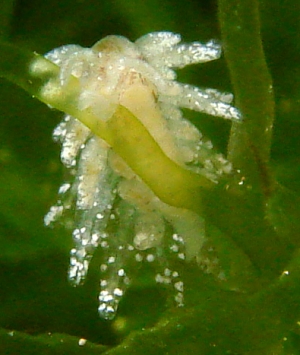
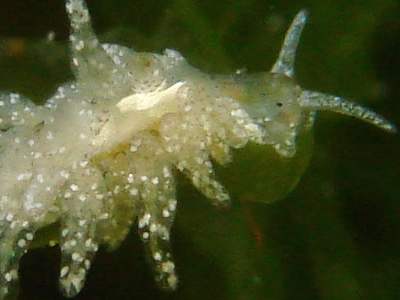
Dear Binyamin,
It certainly looks like it could be a species of Ercolania but I couldn't really say if it is Ercolania sp. 5. I'll leave the possibility of it feeding on this green filamentous algae to the experts but my guess is that it would be feeding on a smaller algae growing on these filaments.
Best wishes,
Bill Rudman
Re: Ercolania sp 5
May 18, 2007
From: Cynthia Trowbridge
Concerning message #19873:
Dear Bill and Kathe,
Hi. Thanks for the message. The Hiranos have been dissecting Ercolania spp. radulae and reproductive systems the last few weeks. We hope to have details soon :-) With so many undescribed or unrecognized species in Japan, we have been working our way through the genera. Thanks for your patience.
Cordially,
Cynthia
trowbric@yahoo.com
Trowbridge, C.D., 2007 (May 18) Re: Ercolania sp 5. [Message in] Sea Slug Forum. Australian Museum, Sydney. Available from http://www.seaslugforum.net/find/19921Dear Cynthia,
Your message arrived just as I was posting one from Kathe [#19911] in which I wonder what you and the Hiranos think on the topic. Talk about an instant response! I look forward to hearing of Yoshi and Yayoi's discoveries.
Best wishes,
Bill Rudman
Re: Ercolania sp. 5 [1]
May 18, 2007
From: Kathe R. Jensen
Concerning message #16458:
Dear Bill,
The animals in Yukari Tani's message appear to be missing the large medial cerata in the anterior end. If you look at the anteriormost cerata, they appear to be very small (newly formed). I have seen Ercolania coerulea spontaneously autotomize the larger cerata when the chloroplasts had turned pale/brownish. Although this was in aquaria and thus may not be a natural phenomenon, it was not in response to physical irritation.
Best wishes,
Kathe
krjensen@snm.ku.dk
Jensen. K.R., 2007 (May 18) Re: Ercolania sp. 5 [1]. [Message in] Sea Slug Forum. Australian Museum, Sydney. Available from http://www.seaslugforum.net/find/19911Dear Kathe,
Thanks for your quick response. You are probably correct. There certainly are signs of autotomy in the photos, and body damage. I also have had bad experiences collecting and photographing E. coerulea in Tanzania [message #6580, #13310] - they seem to drop their cerata very easily.
It would be interesting to know if the animal I have been calling Ercolania sp. 5 is found on Valonia sp. or Dictyosphaeria cavernosa which seem to be the food algae of E. coerulea.
Before I start splitting up the 'page' it would be interesting to here the views of Yoshi Hirano or Cynthia Trowbridge
Best wishes,
Bill Rudman
Re: Ercolania sp 5
May 15, 2007
From: Kathe R. Jensen
Concerning message #19445:
Dear Bill,
Reading the latest message on Ercolania sp. 5, I noticed that a couple of the messages on this species, including the one in the fact sheet, are almost certainly Ercolania coerulea. The dense branching of digestive gland, the branching into the rhinophores and the rather broad foot are distinct indications of this species.
I have no idea about the identity of the animal in the remaining messages of Ercolania sp. 5, so I guess you can keep that entry - though with a different picture for the fact sheet.
Best wishes,
Kathe
krjensen@snm.ku.dk
Jensen, K.R., 2007 (May 15) Re: Ercolania sp 5. [Message in] Sea Slug Forum. Australian Museum, Sydney. Available from http://www.seaslugforum.net/find/19873Thanks Kathe,
I agree there appear to be 2 species on this page but my image of E. coerulea is an animal with its whole back covered with swollen cerata. The animal in the Ercolania sp. 5 Fact Sheet has elongate cerata with a wide gap in at least the front half of the body between the left and right cerata. I realise cerata can be cast off but that doesn't seem to be the case here.
Rather than tentatively rearrange the photos identified as 'Ercolania sp. 5' I've put a note about your concerns on the Fact Sheet and hope someone will publish on the fascinating groups of lookalikes in the not too distant future
Best wishes,
Bill Rudman
Re: Ercolania sp. 5 from nthn Mariana Islands
May 1, 2007
From: Yuji Fujie
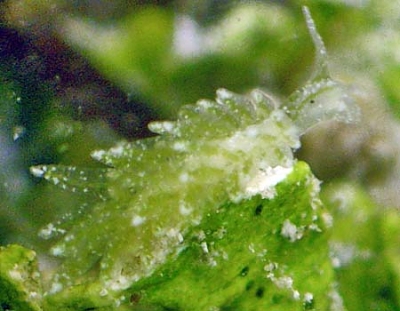
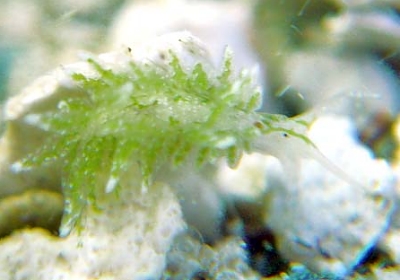
Concerning message #15928:
Dear Dr.Bill,
I took some new pictures of Ercolania sp.5.
This animal was hidden in the seaweeds such as Boodlea coacta though I am not an expert on seaweed identifications. And, I saw a brown mark on the dorsum.
Locality: Eelgrass Beds, Garapan, 1.5 m, Saipan, Northern Mariana Islands, Pacific Ocean, 6 February 2007, in the Boodlea coacta (?). Length: 4 mm. Photographer: Yuji Fujie.
Best regards,
Yuji
dswith@isletwind.com
Yuji Fujie, 2007 (May 1) Re: Ercolania sp. 5 from nthn Mariana Islands. [Message in] Sea Slug Forum. Australian Museum, Sydney. Available from http://www.seaslugforum.net/find/19445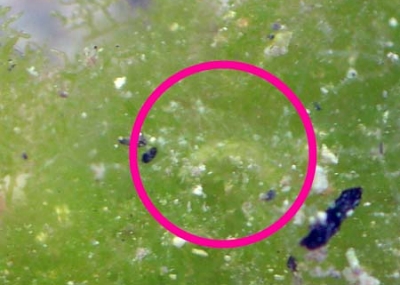
Thanks Yuji,
These animals are often very well camouflaged on their algal food
Best wishes,
Bill Rudman
Re: Ercolania sp. 5 [2]
April 27, 2006
From: Yukari Tani
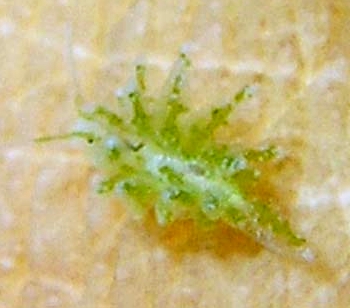
Concerning message #16360:
Dear Dr.Cynthia and Dr.Bill,
We have found a picture of the same specimen as in message #15928.
Locality: Eelgrass Beds, Garapan, 1.5 m, Saipan, Philippine Sea, 13 December 2005, on the seaweeds. Length: 2 mm. Photographer: Yukari
Best regards,
Tani.
dswith@isletwind.com
Yukari Tani, 2006 (Apr 27) Re: Ercolania sp. 5 [2]. [Message in] Sea Slug Forum. Australian Museum, Sydney. Available from http://www.seaslugforum.net/find/16459Dear Gon,
Thanks,
Bill Rudman
Re: Ercolania sp. 5 [1]
April 27, 2006
From: Yukari Tani
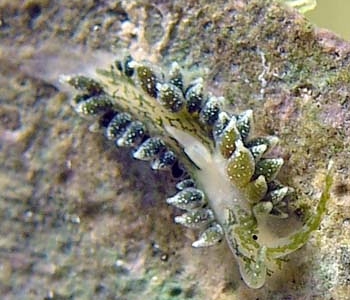
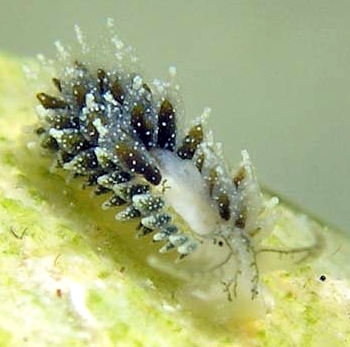
Concerning message #16360:
Dear Dr.Cynthia and Dr.Bill,
Thank you for your message.
I attach 3 photos showing 2 specimens of the animal in our message #15927.
We couldn't find red markings.
Locality: Eelgrass Beds, 1.5 m, Saipan, Philippine Sea, 04 January 2006, Backside of stome on sands.. Length: 10mm. Photographer: Yukari Tani.
We hope these pictures help you.
Best regards,
Gon
dswith@isletwind.com
Yukari Tani, 2006 (Apr 27) Re: Ercolania sp. 5 [1]. [Message in] Sea Slug Forum. Australian Museum, Sydney. Available from http://www.seaslugforum.net/find/16458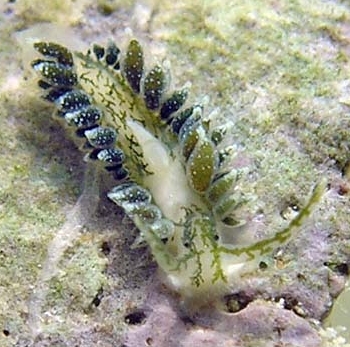
Dear Gon,
I am sure these photos will be of assistance.
Best wishes,
Bill Rudman
Re: Placida dendritica or Ercolania subviridis ? [1]
April 22, 2006
From: Cynthia Trowbridge
Concerning message #15927:
Dear Gon and Bill,
Thank you for posting images of this species. I would agree with the assessment that the species is an Ercolania sp. (neither Placida dendritica nor Ercolania subviridis). The rhinophore shape, cerata shape, and cerata diverticulae (unbranched) all look like Ercolania spp. that we are finding regularly in Okinawa on various green algae.
Members of the Hirano lab group (Chiba University) have been dissecting the radulae of our Ercolania and Placida spp. It is too early to state exactly how many species are involved but there are at least 3 Placida spp. and at least 2-3 Ercolania spp. being recorded in Japan and environs under the name Placida dendritica. Last week, Yoshi Hirano talked about this problem at the Japanese malacology meeting in Tokyo: Cryptic species of a common Japanese sacoglossan, "Midoriamamo-umiushi" by Hirano Y.J., Hirano Y.M., and Trowbridge, C.D.
I am not used to seeing lateral views of these Ercolania species as we usually take dorsal photographs. It would be helpful to know if there were any dorsal red markings along the mid-dorsal line. At least two species of Ercolania have such markings. If you find more slugs, Gon, please take a few dorsal shots of the animals (with the cerata spread) as well as the algal food. Both types of information would be extremely helpful. Thanks for your message!
Cordially,
Cynthia
trowbric@yahoo.com
Trowbridge, C.D., 2006 (Apr 22) Re: Placida dendritica or Ercolania subviridis ? [1]. [Message in] Sea Slug Forum. Australian Museum, Sydney. Available from http://www.seaslugforum.net/find/16360Thanks Cynthia,
Your work with the Hiranos sounds very interesting. I'll elevate this species from the 'unidentified' list to Ercolania sp. 5.
Best wishes,
Bill Rudman
Placida dendritica or Ercolania subviridis ? [1]
February 24, 2006
From: Yukari Tani
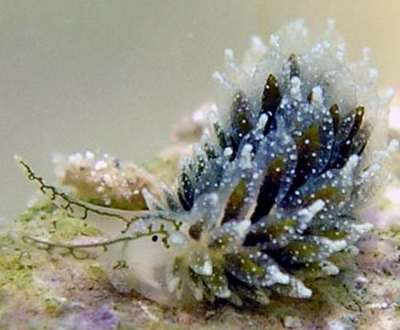
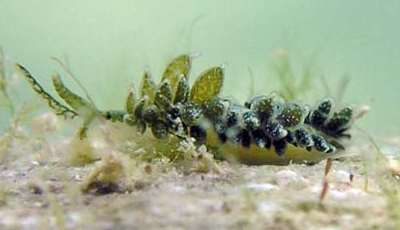
Dear Dr.Bill,
We judged this species to be Ercolania subviridis in the beginning because the feeler is a cylinder shape. But when I found message #7149 - Placida dendritica from Scotland - we are confused again.
Locality: Eelgrass Beds, 1.5 m, Saipan, Northern Mariana Islands, Pacific Ocean, 04 January 2006, Backside of stone on sands. Length: 10 mm. Photographer: Yukari Tani.
Would you give us your advice, please ? I've sent a second message [#15928 ] with a similar problem.
Best regards,
Gon
dswith@isletwind.com
Yukari Tani, 2006 (Feb 24) Placida dendritica or Ercolania subviridis ? [1]. [Message in] Sea Slug Forum. Australian Museum, Sydney. Available from http://www.seaslugforum.net/find/15927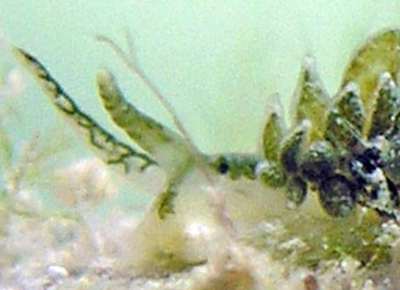
Dear Gon,
There's no shame on being confused with these animals. It will need a lot more observations and dissections before we have them sorted out.
I suspect your species is an Ercolania, but I don't think it is E. subviridis. In that species the ceratal digestive gland has a series of longitudinal green ducts, while in your animal the ceratal digestive appears to be an expandable sac, giving the ceratal wall a greenish tinge all over when the digestive duct is expanded.
I think I should leave this to an expert on this group. Perhaps Kathe Jensen or Cynthia Trowbridge would like to say something?
Best wishes,
Bill Rudman
Placida dendritica or Ercolania subviridis ? [2]
February 24, 2006
From: Yukari Tani
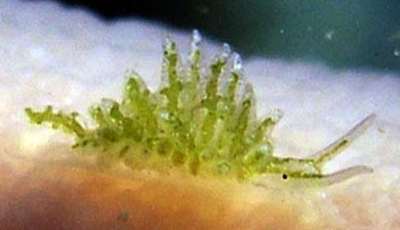
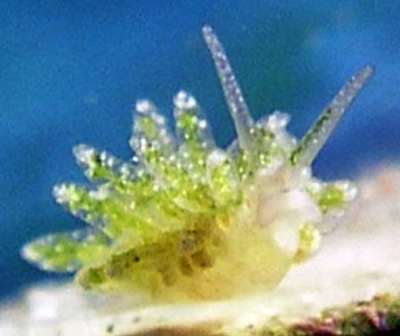
Dear Dr.Bill,
This is a continuation of our last message [#15927]. We also judged this species to be Ercolania subviridis in the beginning because the feeler is a cylinder shape.
Would you give us your advice, please ?
Locality: Eelgrass Beds, 1.5 m, Saipan, Northern Mariana Islands, Philippine Sea, 13 December 2005, on the seaweeds. Length: 2 mm. Photographer: Yukari Tani.
Best regards,
Gon
dswith@isletwind.com
Yukari Tani, 2006 (Feb 24) Placida dendritica or Ercolania subviridis ? [2]. [Message in] Sea Slug Forum. Australian Museum, Sydney. Available from http://www.seaslugforum.net/find/15928Dear Gon,
I'm afraid my answer is the same as the one I gave your last message. Let's hope that an expert in the group can help us.
Best wishes,
Bill Rudman
